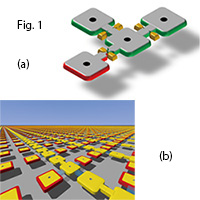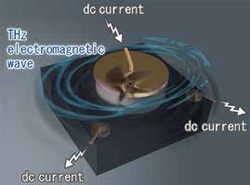- Home
- > Outreach
- > Publications
- > CONVERGENCE
- > ASKING THE RESEARCHER
 ASKING THE RESEARCHER
ASKING THE RESEARCHER
Xiao Hu MANA Principal Investigator, Unit Director, Nano-System Theoretical Physics Unit, Nano-System Field
Topological Nanoarchitectonics
Searching for new quantum functionalities

Up to now, high performance of computer has been pursued by miniaturizing individual semiconductor devices. However, thinner wires carrying electrons used for bit calculations exhibit larger electrical resistance and generate a larger amount of heat, which should be cooled by a larger cooling equipment costing more energy. To avoid this deadlock, development of a completely new operating principle has become an urgent issue.
Quantum information technology in which information processing is performed by utilizing quantum states has attracted significant interest as a next-generation science and technology. Quantum computer, which makes use of quantum properties at nanometer scale, is expected to be able to process large amounts of information at ultra-high speed. It is useful for the-state-of-art encryption and quantum simulation for developing novel materials. Even the quantum teleportation would not be a dream.
With this background, Dr. Hu is engaged in research discovering new quantum mechanical properties and their applications. “For physicists around the world, realizing a quantum computer is certainly an ultimate goal. However, before reaching this goal, there are many problems that must be solved. We are now engaged in basic research to overcome these problems. During this process, many discoveries on novel phenomena have been and will be achieved as serendipity.”
Topological nanoarchitectonics
“Topology” originally is a concept of mathematics that describes the invariant property of objects subject to continuous deformation. In physics, it turns out that a unified and useful picture can be derived when the concept of topological invariant is applied to quantum mechanical wave functions of materials.*
Because topology of a material is an intrinsic characteristic determined by the global property, Dr. Hu is carrying on a variety of researches to design robust nano quantum devices making use of topology, which can exhibit functionalities beyond the limitation generally believed before. He coined the terminology of “topological nanoarchitectonics”. Design of a quantum nano device for manipulating Majorana fermions is one example.
A Majorana fermion is a special type of fermion which is equivalent to its own antiparticle. Their existence as an elementary particle still has not been confirmed. However, in recent years, it has become clear that on the surface of a topological superconductor excited states within the superconducting gap, sometimes called quasiparticles, behave in quite a similar way as Majorana fermions.
As Dr. Hu explains, “One challenge that must be overcome in order to realize a stable quantum computer is the fact that quantum states are easily destroyed for example by electromagnetic field noises from environment. This phenomenon is known as decoherence. Now scientists believe that the problem of decoherence can be resolved by using Majorana fermions, which are stable because they are protected by the topology. This is the main reason why we are focusing on topological superconductivity.”

However, because Majorana fermions are electrically neutral, a consequence of equivalence between particle and antiparticle, they are not easy to be derived by electromagnetic field. To solve this problem, Dr. Hu and his colleagues for the first time in the world carried out a detailed quantum mechanical analysis and succeeded in designing a quantum device with which one can manipulate Majorana quasiparticles merely by turning local gate voltages on and off (Fig. 1) with nano seconds. It was confirmed that positional exchange of Majorana quasiparticles by this device follows non-Abelian quantum statistics, which can be used for topological quantum calculation. Dr. Hu says, “The goal of achieving robust quantum computer is certainly getting closer.”
Fig. 1 (a) Schematic diagram of nano quantum devices for manipulating Majorana quasiparticles. Vortices are pinned at the center of samples as denoted by the black dots. Constricted junctions are created between samples, and gate voltages can be applied there. The connection between samples is controlled by adjusting the gate voltage.
When an odd number of vortices exist in one sample or connected samples, Majorana quasiparticles appear at the sample edge. The Majorana quasiparticles disappear in case of an even number of vortices. Utilizing this property, the edge Majorana quasiparticles can moved and their positions can be exchanged simply by turning the gate voltages at constriction junctions on and off in a certain sequence.
(b) Schematic diagram of an array of topological quantum bits.
From novel physical phenomena to functionality
Dr. Hu is always making effort to explain complicated physical phenomena in a way that people can understand plainly, and to create functionalities based on these phenomena from which human being can benefit. One example is the discovery of the mechanism for radiation of terahertz electromagnetic wave based on nano superconductivity.
In 2007, it was experimentally observed that nano Josephson junctions built in a single crystal of bismuth-based high-temperature superconductor (called intrinsic Josephson junctions) emitted coherent terahertz electromagnetic waves. While it was soon noticed as an important breakthrough, no theoretical explanation was available at that time, which is however indispensable for enhancing radiation power for practical uses. Using large-scale computer simulations and theoretical analysis, Dr. Hu and his colleagues discovered a novel quantum state of superconducting phase. His theory clarified the fact that the intrinsic Josephson junctions function effectively as “nano-windmills”, in which a dc current behaves as the blowing wind, phase kinks in nano Josephson junctions are the blades of windmills, and the generation of terahertz electromagnetic wave is similar to the current generated by rotation of the windmills (Fig. 2). This theoretical understanding proved the possibility of realization of strong quantum source for terahertz electromagnetic waves based on nano Josephson junctions. A 50-year dream since the discovery of Josephson effects is coming true. Terahertz electromagnetic waves are useful in DNA pathological examination and medicine analysis, and when used for security check at airport, they are not harmful for human body.

Fig. 2 Schematic diagram of a nano-windmill formed by a stack of intrinsic Josephson junctions in a single crystal of high-temperature superconductor Under a dc voltage bias, a phase kink is developed inside each Josephson junction and works as a rotating windmill (approximately 700 windmills are stacked in the cylindrical mesa of 1 μm tall above the substrate as shown in the figure). This transfers the injected dc energy into terahertz electromagnetic wave radiated into free space from the side surface of the cylindrical mesa.
Devotion, humor and colleagues
Dr. Hu says that the real pleasure as a theoretical physicist comes when a material designed based on physics insight and accurate calculations displays wonderful physical properties through experiments. “There’s nothing better than this pleasure. I love to do research. I’d like to devote my whole life for research.”
However, even Dr. Hu, who feels this way about his work, frequently gets stuck in research. At such times, he feels encouraged to remember the words that he received from his wife, “Inspiration comes of working.”
“In spite of those setbacks, I always try to make my work enjoyable, and not a restless struggle. Research is a series of failures. It’s important to have a sense of humor so that they don’t get the best of you. It’s also important to have a lot of colleagues who can share both the good and the difficult times.”
The property that a mag and a donut can be changed into each other by continuous deformation is understood as topological equivalence. Around 1850 Cauchy noticed that the integration of curvature over an object can only take an integer multiple of , and that objects can be categorized by this integer, the beginning of a branch of mathematics called topology. It became clear in recent years that, when electrons move in periodic potentials created by ions carrying plus charges, their quantum mechanical wave functions in momentum space exhibit properties similar to the curvature of donut. Topology is becoming a new central concept in condensed matter physics and related materials science.

